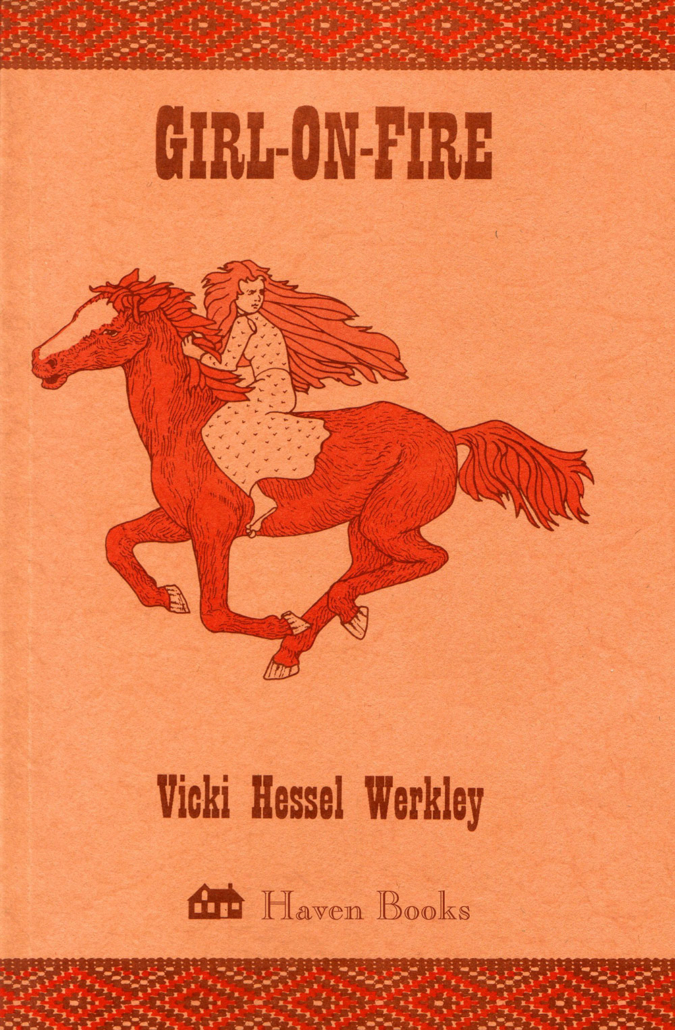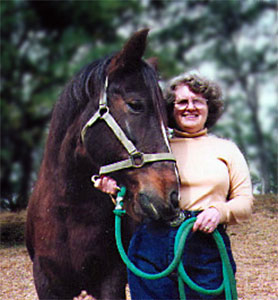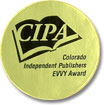More Haven Books Fiction
Vicki Hessel Werkley’s
Girl-On-Fire
Winner – Silver Independent Publishers Book Award for Multi-Cultural Fiction
Winner – Gold EVVY Award for Legacy Fiction
Captured by a warparty and swept into Comanche tribal life, can homesteader Carrie McEdan make a place for herself in this alien culture?
This award-winning offering from Haven Books is historical fiction offering the reader a fresh perspective on an important chapter of the American West.
Based upon exhaustive research and collaboration with the Comanche Language and Cultural Preservation Committee, author Vicki Hessel Werkley’s debut novel thunders across the 1874 plains of Texas and Oklahoma. While the Red River War rages, the personal drama of Carrie McEdan unfolds as she’s abducted from the harsh wind-torn life she’s known in a soddy, and is swept into Comanche tribal life.
Though “kidnap fiction” of the old West has existed for decades, this book goes well beyond the stereotypical view of Native American tribal life. “In most Anglo-fiction, Native women were nearly always portrayed as powerless and subservient to their men,” states Werkley. “But in fact, women had control of the heart of the community and had an enormous say in how tribal affairs were organized and run.”
A restless girl of sixteen — irritated by the drudgery of women’s work and the unjust limitations of her white society — Carrie longs for adventure and romance until uninvited guests catch her at home alone. Not only does she brave the terror of kidnap, but the danger and mystery of being unable to communicate with her captors or to understand the motives behind their often-unexpected behavior. Through Carrie McEdan we experience the strength and adaptability of the human character as it seeks survival and acceptance, love and spiritual connection.
Werkley, a former educator with the Mendocino Unified Schools, began her writing career in second grade, and by her sophomore year was the recipient of First Place Award for Senior Short Story from the National Scholastic Writing Awards. She’s been widely published in periodicals including Datebook, Teenset, and Starlog, has written television scripts, and has edited a newsletter for a non-profit organization since 1991. She is the professional editor of the biography The Man Behind the Miracle (November, 1999), and of five novels: Page Street (July, 1993), What the Heart knows, Closer Than You Think, Child Secrets, and Captain Mary, Buccaneer (2000).
More About This Book
Book Club and Reading Group Guide - Topics for Discussion
- What was Carrie’s life on the prairie like before her kidnap? Were there aspects of Carrie’s new life with the Comanche that were better than the life she left behind? What aspects was Carrie unable to accept? How did she handle this?
- Why didn’t Carrie try to escape once she was captured? How did the reasons change as time went by? Was she “brainwashed” to stay? Was she being practical because her chances for survival alone in the wild were slim? What other factors influenced her?
- Carrie is forced to live in a situation where other people have power over her. Do modern teenagers ever live in similar circumstances? Do women in our society ever give up their power? What could they learn from Carrie?
- Do you believe in fate? Or do you believe fate can be overcome? Was Danny destined to be with Carrie? Or do you think the prophetic dreams Carrie and Blackhorse had, meant they should be destined for each other?
- Did you learn anything new about Comanche culture? What one thing intrigued/surprised/entertained you the most? What aspects of Native American culture and tradition could be valuable in modern life?
- In 1874, what was the role of women in Comanche tribal life? What was the role of women in Euro-American frontier life? In which culture were women more valued? How were these values expressed differently in each culture?
- Carrie was raised in a Protestant religion, but was then exposed to a new form of spiritual worship. Did her spiritual sense expand as a result of her experience? Does spiritual awareness help us with adversity?
- How does a person tell whether the inner voice they’re trusting is truly their own inner voice, or some form of “wishful thinking” or external influence?
- As a former educator with the Mendocino Unified School District, Vicki Werkley was trained in both academics and psychology. How might her teaching background have influenced her as a novelist?
- Why is this book called Girl-On-Fire? Does this refer only to the name given to Carrie by the Comanche? Or does it have metaphorical significance as well?
Readers’ Comments
Do you have a comment? Please e-mail us! email hidden; JavaScript is required
Here’s what other readers have said:
“In a display of pluck and determined resistance to her kidnappers, Carrie McEdan becomes Girl-on-Fire, the name her Comanche captor, Blackhorse, gives her in the summer of 1874. It is Carrie’s luck to be the manifestation of a dream and that enables her to survive, as does her openness to learning the language and custom of a new people.
Marked for marriage to her captor, she escapes that fate in the immediate present when he and the other warriors answer yet another call from Quanah Parker and head into battle that takes them from the band for several weeks. Most Comanche have succumbed to the white man’s destruction of their native way of life and have gone onto the reservations, except for Quanah’s group and a few other bands. During Blackhorse’s absence, Carrie/Girl-on-Fire learns the ways of the people and immerses herself in the culture. In her own dream/vision, clues about her fate come to her that she has trouble discerning.
Vicki Hessel Werkley tells her tale with passion, honor and great sensitivity. This is the story of a survivor, not of misfortune but of great good fortune, in her experience among the people. Carrie learns new skills, respect for the women’s role in her new setting, and a system of values and traditions she comes to respect. The reader is caught up in the romance and visions, just as the writer intended.”
— Arletta Dawdy, author of The Huachuca Trilogy
I could not put that book down! In some ways it was like a sexy romance story. And on the other hand it had sudden twists and turns. All the surprises when you think you have it figured out! Couldn’t believe all the things that happened. It seemed to be very authentic. It was most enjoyable.
— Jean Smith, Colorado Springs, Colorado
Rarely do books written by non-Indians find approval with Native Americans, but Werkley’s respectful research and attention to detail have earned her the cooperation and esteem of the Comanche people who assisted her, two of whom say….
“Girl-On-Fire is a superbly written book . . . extraordinarily accurate about the daily life and responsibilities of Comanche women and with the Comanche language appropriately used. Vicki Werkley has done an outstanding job in her research of the Comanche People. I give this book two thumbs up!”
— Thekwane (Jolene Jimenez), Comanche Tribal Princess, 1988
“Girl-On-Fire was a pleasure! The closest book I have read to capturing the true essence of Comanche Women!”
— Diana G. Sovo, Personnel Director, Comanche Nation; Comanche Tribal Princess, 1983
From the School Library Journal Annual Policy Statement:
“Adult Books for Young Adults” category
“Books reviewed are considered noteworthy in their appeal to young adults for pleasure and/or research and are chosen for their literary merit and their ability to inspire, challenge, instruct, and/or entertain teens. Because these books were written for adults, readers must assume they may contain mature themes.”
From the review for Girl-On-Fire (by Vicki Hessel Werkley): “The strength of this book is in the rich details of Native American culture in the 1870s. The smell of wood smoke and simmering stews; the ‘tidy efficiency’ of a tepee with its inner drape, rawhide trunks, and willow-slat beds; and the sounds of the language and songs all encourage readers to experience the human complexities of tribal life. Even teens reluctantly fulfilling a dreaded historical fiction assignment should become caught up in the protagonist’s bittersweet adventure with a people who will soon face many tragic losses of their own.”
— Dori DeSpain, reviewer, School Library Journal, January, 2000 issue (review begins on page 158)
Download The School Library Journal Review of “Girl-On-Fire”




